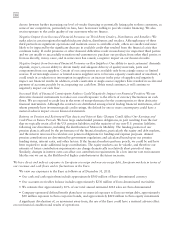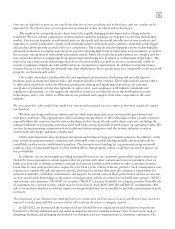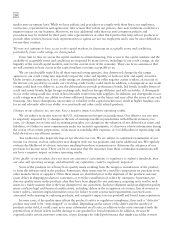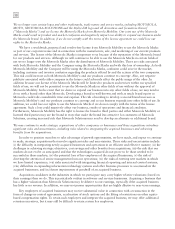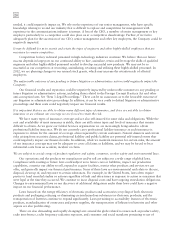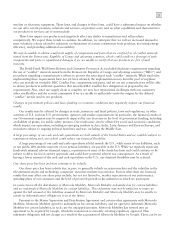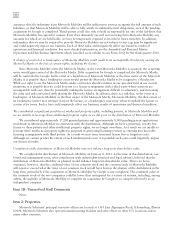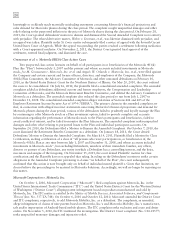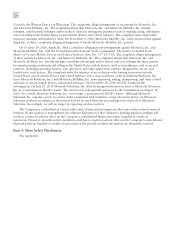Motorola 2011 Annual Report Download - page 24
Download and view the complete annual report
Please find page 24 of the 2011 Motorola annual report below. You can navigate through the pages in the report by either clicking on the pages listed below, or by using the keyword search tool below to find specific information within the annual report.
18
We no longer own certain logos and other trademarks, trade names and service marks, including MOTOROLA,
MOTO, MOTOROLA SOLUTIONS and the Stylized M logo and all derivatives and formatives thereof
(“Motorola Marks”) and we license the Motorola Marks from Motorola Mobility. Our joint use of the Motorola
Marks could result in product and market confusion and negatively impact our ability to expand our business under
the Motorola brand. In addition, if we do not comply with the terms of the license agreement we could lose our
rights to the Motorola Marks.
We have a worldwide, perpetual and royalty-free license from Motorola Mobility to use the Motorola Marks
as part of our corporate name and in connection with the manufacture, sale, and marketing of our current products
and services. The license of the Motorola Marks is important to us because of the reputation of the Motorola brand
for our products and services. Although we will continue to be able to use the Motorola Marks in certain fields of
use we no longer own the Motorola Marks after the distribution of Motorola Mobility. There are risks associated
with both Motorola Mobility and the Company using the Motorola Marks and with this loss of ownership. As both
Motorola Mobility and the Company will be using the Motorola Marks, confusion could arise in the market,
including customer and investor confusion regarding the products offered by and the actions of the two companies.
This risk could increase as both Motorola Mobility’s and our products continue to converge. Also, any negative
publicity associated with either company in the future could adversely affect the public image of the other. In
addition because our license of the Motorola Marks will be limited to products and services within our specified
fields of use, we will not be permitted to use the Motorola Marks in other fields of use without the approval of
Motorola Mobility. In the event that we desire to expand our business into any other fields of use, we may need to
do so with a brand other than Motorola. Developing a brand as well-known and with as much brand equity as
Motorola could take considerable time and expense. The risk of needing to develop a second brand increases as
Motorola Mobility’s and our products continue to converge and as our business expands into other fields of use. In
addition, we could lose our rights to use the Motorola Marks if we do not comply with the terms of the license
agreement. Such a loss could negatively affect our business, results of operations and financial condition.
Furthermore, Motorola Mobility has the right to license the brand to third parties and either Motorola Mobility or
licensed third parties may use the brand in ways that make the brand less attractive for customers of Motorola
Solutions, creating increased risk that Motorola Solutions may need to develop an alternate or additional brand.
We may continue to make strategic acquisitions of other companies or businesses and these acquisitions introduce
significant risks and uncertainties, including risks related to integrating the acquired businesses and achieving
benefits from the acquisitions.
In order to position ourselves to take advantage of growth opportunities, we have made, and expect to continue
to make, strategic acquisitions that involve significant risks and uncertainties. These risks and uncertainties include:
(i) the difficulty in integrating newly-acquired businesses and operations in an efficient and effective manner; (ii) the
challenges in achieving strategic objectives, cost savings and other benefits from acquisitions; (iii) the risk that our
markets do not evolve as anticipated and that the technologies acquired do not prove to be those needed to be
successful in those markets; (iv) the potential loss of key employees of the acquired businesses; (v) the risk of
diverting the attention of senior management from our operations; (vi) the risks of entering new markets in which
we have limited experience; (vii) risks associated with integrating financial reporting and internal control systems;
(viii) difficulties in expanding information technology systems and other business processes to accommodate the
acquired businesses; and (ix) future impairments of goodwill of an acquired business.
Acquisition candidates in the industries in which we participate may carry higher relative valuations (based on
their earnings) than we do. This is particularly evident in software and services businesses. Acquiring a business that
has a higher valuation than Motorola Solutions may be dilutive to our earnings, especially if the acquired business
has little or no revenue. In addition, we may not pursue opportunities that are highly dilutive to near-term earnings.
Key employees of acquired businesses may receive substantial value in connection with a transaction in the
form of change-in-control agreements, acceleration of stock options and the lifting of restrictions on other equity-
based compensation rights. To retain such employees and integrate the acquired business, we may offer additional
retention incentives, but it may still be difficult to retain certain key employees.




